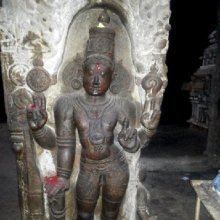Parivaradevata, Parivāradevata, Parivara-devata: 2 definitions
Introduction:
Parivaradevata means something in Hinduism, Sanskrit. If you want to know the exact meaning, history, etymology or English translation of this term then check out the descriptions on this page. Add your comment or reference to a book if you want to contribute to this summary article.
Images (photo gallery)
In Hinduism
Shilpashastra (iconography)
Source: Wisdom Library: Elements of Hindu IconograpyIn a svayampradhāna temple of Subrahmaṇya there are required to be set up eight parivāra-devatas, namely,
- Yakṣendra,
- Rākṣasendra,
- Piśāchendra,
- Bhūtarāṭ,
- Gandharva,
- Kinnara,
- Daityanāyaka and
- Dānavādhipa.
The figures of these are to be placed on the eight cardinal points of the prākāra; Yakṣendra being on the east, Rākṣasendra on the south-east and so on. These Parivāra-devatās are to be sculptured as having two or four arms and they should be of dark complexion and terrific look. If they have four arms, two of the hands are to be held in the varada and the abhaya poses, while the remaining two should carry the khaḍga and the kheṭaka. But if they have only two arms, the hands should keep the khaḍga and the kheṭaka.
The Kumāra-tantra mentions a much larger number of parivāra-devatās; eight, twelve, sixteen or thirty-two devatas are prescribed in it. If eight devatas are to be set up, we are told that
- on the east, facing the deity, should be the figure of an elephant;
- on the south-east, Śāsta;
- in the south, Brahmā;
- on the south-west, the Sapta-mātṛkās;
- on the west, Jyeṣṭhā;
- on the north-west Durgā;
- on the north, Kṣetrapa
- and on the north-east, Sumitraka.
The names of the parivāra-devatas of the groups of twelve are:
- the elephant,
- Sūrya,
- Śāsta,
- Brahmā,
- Yama,
- Sapta-mātṛkās,
- Varuṇa,
- Agastya,
- Durgā,
- Bārada,
- Śrīśa and
- Sumitra.
The following are the names of the sixteen parivāra-devatās:—
- the elephant,
- Brahmā,
- Agastya,
- Nārada,
- Sumitraka,
- Śukra,
- Bṛhaspati,
- Durgā,
- Ditī,
- Aditī,
- Dhandra,
- Sūrya,
- Śāsta,
- Mahālakṣmī,
- Bhāratī and
- the Sapta-mātṛkās.
To make up the thirty-three parivāra-devatas, the following are added to the above mentioned sixteen deities, namely, the
- Aṣṭa-dikpālakas,
- Sudeha,
- Sureśa,
- Sukukha,
- Bhṛṅgi,
- Vāsuki,
- Aṣṭavara
- (vakra ?),
- Bhṛṅgi
- (Bhṛgu ?),
- Dakṣa-Prajāpati,
- Vīrabhadra,
- Śukra,
- Bhū,
- Jyeṣṭha
- and two others.
Parivāradevata (परिवारदेवत) refers to the “gods related in a family” whose images are found scattered within Hindu temples.—T. A. Gopinath Rao points out the specificities of each temple by saying that each temple is filled with numerous images of gods, goddesses, parivāra-devatas (gods related in a family), devas (attendants to the gods), śālagrāmās (cakra–an ammonite shell), bānaliṅgās (egg-shaped pebbles), yantras (mystic and magical diagrams engraved upon metallic plates), navagrahas (the nine planetary divinities), certain divine animals and birds, certain holy rivers, tanks, trees and sepulchers of saints.

Shilpashastra (शिल्पशास्त्र, śilpaśāstra) represents the ancient Indian science (shastra) of creative arts (shilpa) such as sculpture, iconography and painting. Closely related to Vastushastra (architecture), they often share the same literature.
See also (Relevant definitions)
Partial matches: Devata, Parivara.
Full-text: Banalinga, Navagraha, Hindu Temple, Subrahmaṇya.
Relevant text
Search found 5 books and stories containing Parivaradevata, Parivāradevata, Parivara-devata, Parivāra-devata; (plurals include: Parivaradevatas, Parivāradevatas, devatas). You can also click to the full overview containing English textual excerpts. Below are direct links for the most relevant articles:
Middle Chola Temples (by S. R. Balasubrahmanyam)
Mahamandapa and Mukhamandapa < [Tanjavur/Thanjavur (Rajarajesvaram temple)]
Temples in Tirumangalam < [Chapter II - Temples of Rajaraja I’s Time]
Temples in Malur < [Chapter II - Temples of Rajaraja I’s Time]
Temples of Munnur (Historical Study) (by R. Muthuraman)
Siddhi Vinayaga shrine < [Chapter 4]
Images of Jeshta (Jyestha) < [Chapter 5]
Sub shrines < [Chapter 4]
Early Chola Temples (by S. R. Balasubrahmanyam)
Ashta Parivara Devatas < [Chapter XIII - Prasada: Component Parts]
Temples in Erumbur (Urumur) < [Chapter II - Temples of Parantaka I’s Time]
Temples in Erumbur (28th year) < [Chapter X - Historical Survey]
Later Chola Temples (by S. R. Balasubrahmanyam)
Temples in Tidaavur (Tadavur) < [Chapter XII - Temples of Kulottunga III’s Time]
Temples in Tiruvenkadu < [Chapter XIX - Supplement]
Parama Samhita (English translation) (by Krishnaswami Aiyangar)
Related products


